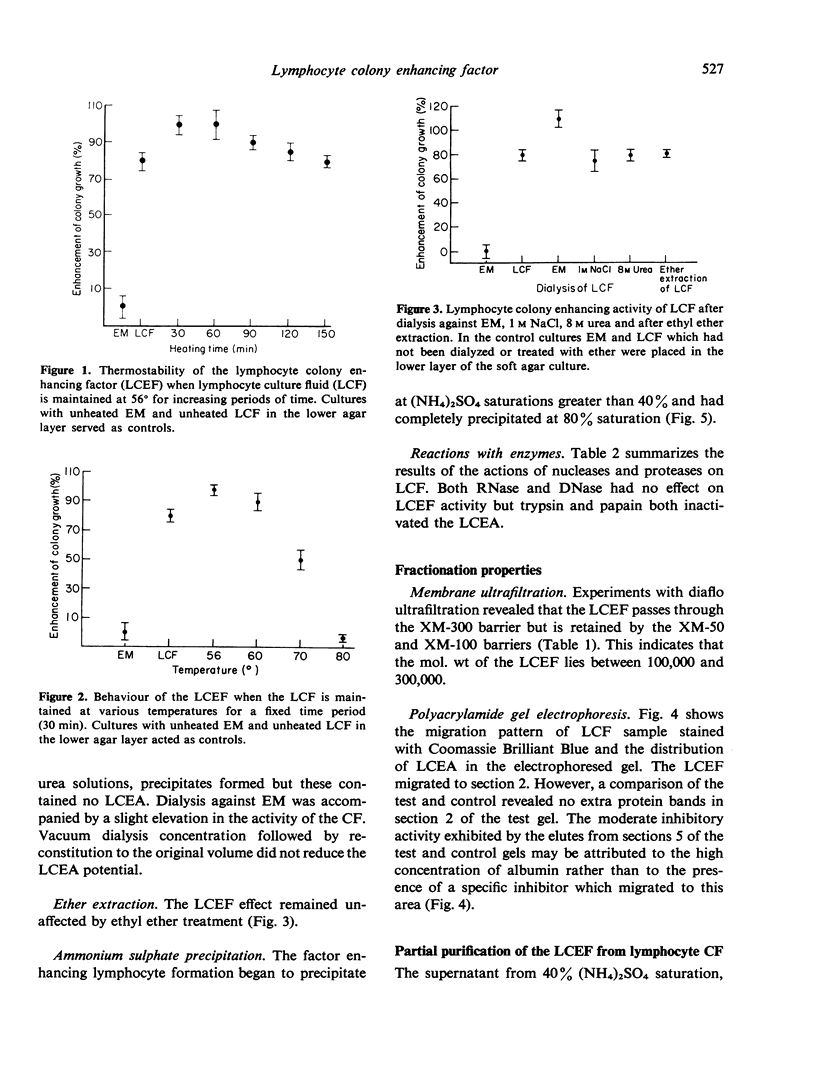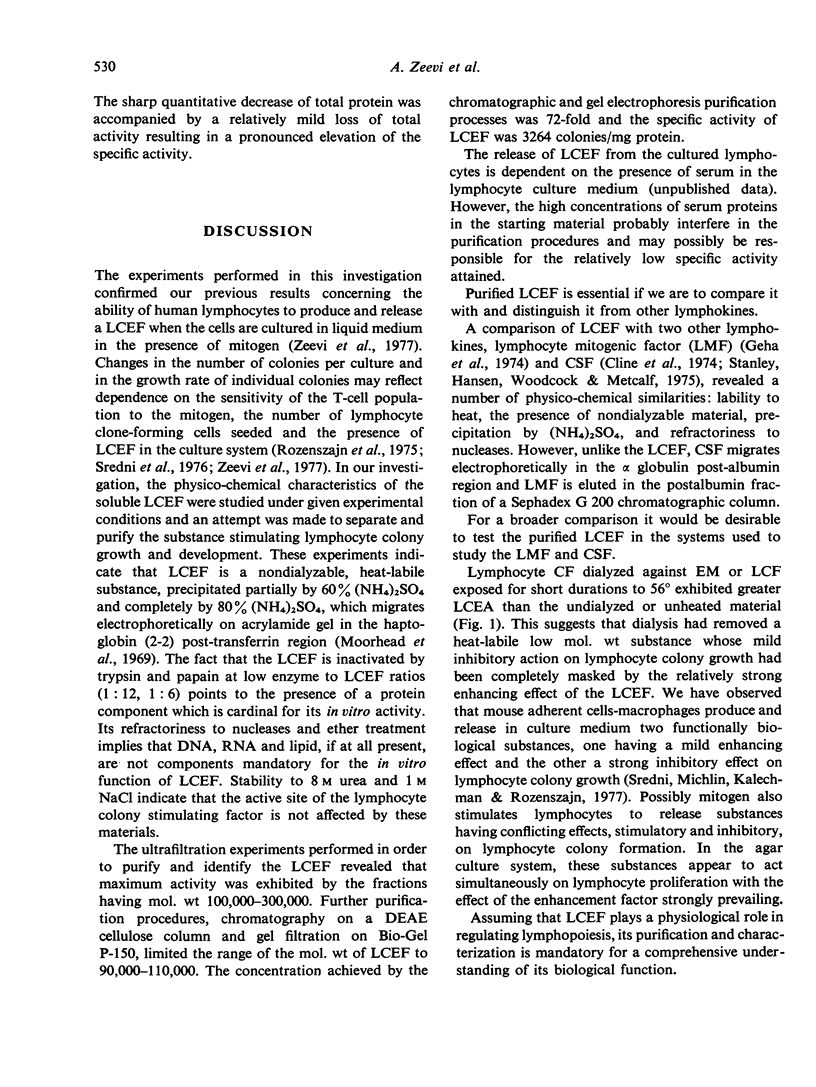Abstract
The cloning potential of PHA-treated T cells is significantly enhanced when lymphocyte culture fluid (LCF) from mitogen-treated lymphocytes is added to the soft agar culture system. The mitogens seem to stimulate the release of a lymphocyte colony enhancing factor (LCEF) into the culture medium. A study of the physico-chemical properties of the LCEF revealed that it is a nondialyzable, heat-labile molecule which migrates in the haptoglobin (2--2) post-transferrin region in acrylamide electrophoresis. It is stable to RNase and DNase but labile to papain and trypsin. The LCEF was partially purified from the crude LCF using a sequence of techniques--ammonium sulphate precipitation, DEAE-cellulose and Bio-Gel P-150 chromatography and disc electrophoresis. The mol. wt of the purified LCEF, determined from gel filtration chromatography, was 90,000--110,000.
Full text
PDF








Images in this article
Selected References
These references are in PubMed. This may not be the complete list of references from this article.
- Badger A. M., Cooperband S. R., Green J. A. Direct observations on the effect of "proliferation inhibitory factor" on the clonal growth of target cells. J Immunol. 1971 Nov;107(5):1259–1267. [PubMed] [Google Scholar]
- Chrambach A., Reisfeld R. A., Wyckoff M., Zaccari J. A procedure for rapid and sensitive staining of protein fractionated by polyacrylamide gel electrophoresis. Anal Biochem. 1967 Jul;20(1):150–154. doi: 10.1016/0003-2697(67)90272-2. [DOI] [PubMed] [Google Scholar]
- Cline M. J., Golde D. W. Production of colony-stimulating activity by human lymphocytes. Nature. 1974 Apr 19;248(5450):703–704. doi: 10.1038/248703a0. [DOI] [PubMed] [Google Scholar]
- David J. R. Delayed hypersensitivity in vitro: its mediation by cell-free substances formed by lymphoid cell-antigen interaction. Proc Natl Acad Sci U S A. 1966 Jul;56(1):72–77. doi: 10.1073/pnas.56.1.72. [DOI] [PMC free article] [PubMed] [Google Scholar]
- Fowles R. E., Fajardo I. M., Leibowitch J. L., David J. R. The enhancement of macrophage bacteriostasis by products of activated lymphocytes. J Exp Med. 1973 Oct 1;138(4):952–964. doi: 10.1084/jem.138.4.952. [DOI] [PMC free article] [PubMed] [Google Scholar]
- GROSS L. Influence of ether, in vitro, on pathogenic properties of mouse leukemia extracts. Acta Haematol. 1956 May;15(5):273–277. doi: 10.1159/000205096. [DOI] [PubMed] [Google Scholar]
- Geha R. S., Merler E. Human lymphocyte mitogenic factor: synthesis by sensitized thymus-derived lymphocytes, dependence of expression on the presence of antigen. Cell Immunol. 1974 Jan;10(1):86–104. doi: 10.1016/0008-8749(74)90154-3. [DOI] [PubMed] [Google Scholar]
- Granger G. A., Kolb W. P. Lymphocyte in vitro cytotoxicity: mechanisms of immune and non-immune small lymphocyte mediated target L cell destruction. J Immunol. 1968 Jul;101(1):111–120. [PubMed] [Google Scholar]
- Holzman R. S., Lebowitz A. S., Valentine F. T., Lawrence H. S. Preparation and properties of cloning inhibitory factor. I. Inhibition of HeLa cell cloning by stimulated lymphocytes and their culture supernatants. Cell Immunol. 1973 Aug;8(2):249–258. doi: 10.1016/0008-8749(73)90114-7. [DOI] [PubMed] [Google Scholar]
- Katz D. H., Benacerraf B. The regulatory influence of activated T cells on B cell responses to antigen. Adv Immunol. 1972;15:1–94. doi: 10.1016/s0065-2776(08)60683-5. [DOI] [PubMed] [Google Scholar]
- LOWRY O. H., ROSEBROUGH N. J., FARR A. L., RANDALL R. J. Protein measurement with the Folin phenol reagent. J Biol Chem. 1951 Nov;193(1):265–275. [PubMed] [Google Scholar]
- Moorhead J. F., Paraskova-Tchernozenska E., Pirrie A. J., Hayes C. Lymphoid inhibitor of human lymphocyte DNA synthesis and mitosis in vitro. Nature. 1969 Dec 20;224(5225):1207–1208. doi: 10.1038/2241207a0. [DOI] [PubMed] [Google Scholar]
- ORNSTEIN L. DISC ELECTROPHORESIS. I. BACKGROUND AND THEORY. Ann N Y Acad Sci. 1964 Dec 28;121:321–349. doi: 10.1111/j.1749-6632.1964.tb14207.x. [DOI] [PubMed] [Google Scholar]
- Parker J. W., Metcalf D. Production of colony-stimulating factor in mitogen-stimulated lymphocyte cultures. J Immunol. 1974 Feb;112(2):502–510. [PubMed] [Google Scholar]
- RABINOWITZ Y. SEPARATION OF LYMPHOCYTES, POLYMORPHONUCLEAR LEUKOCYTES AND MONOCYTES ON GLASS COLUMNS, INCLUDING TISSUE CULTURE OBSERVATIONS. Blood. 1964 Jun;23:811–828. [PubMed] [Google Scholar]
- Rocklin R. E., Remold H. G., David J. R. Characterization of human migration inhibitory factor (MIF) from antigen-stimulated lymphocytes. Cell Immunol. 1972 Nov;5(3):436–445. doi: 10.1016/0008-8749(72)90070-6. [DOI] [PubMed] [Google Scholar]
- Rozenszajn L. A., Michlin H., Kalechman Y., Sredni B. Colony growth in vitro of mitogen-stimulated mouse B lymphocytes. Immunology. 1977 Mar;32(3):319–326. [PMC free article] [PubMed] [Google Scholar]
- Rozenszajn L. A., Shoham D., Kalechman I. Clonal proliferation of PHA-stimulated human lymphocytes in soft agar culture. Immunology. 1975 Dec;29(6):1041–1055. [PMC free article] [PubMed] [Google Scholar]
- Smith J. L., Barker C. R. Production of mitogenic factor by concanavalin A stimulated lymphocytes. Clin Exp Immunol. 1972 Dec;12(4):507–514. [PMC free article] [PubMed] [Google Scholar]
- Sredni B., Kalechman Y., Michlin H., Rozenszajn L. A. Development of colonies in vitro of mitogen-stimulated mouse T lymphocytes. Nature. 1976 Jan 15;259(5539):130–132. doi: 10.1038/259130a0. [DOI] [PubMed] [Google Scholar]
- Stanley E. R., Hansen G., Woodcock J., Metcalf D. Colony stimulating factor and the regulation of granulopoiesis and macrophage production. Fed Proc. 1975 Dec;34(13):2272–2278. [PubMed] [Google Scholar]
- Zeevi A., Goldman I., Rozenszajn L. A. Stimulation and inhibition of human T-lymphocyte colony cell proliferation by hemopoietic cell factors. Cell Immunol. 1977 Feb;28(2):235–247. doi: 10.1016/0008-8749(77)90108-3. [DOI] [PubMed] [Google Scholar]



